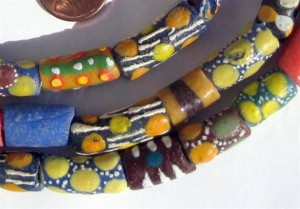Venetian Trade Beads – Why they are nicknamed ‘talking beads’, by the Ashanti of Africa
Ashante (Asanti), in the heart of Ghana, is a state synonymous with tribal expression and ritual. The Akans (Ashante people) have held precedence as a dominant tribe ever since the 17th Century, when they ruled and controlled most of the 'Gold Coast' (now known administratively as Ghana.) Ghana is also synonymous with the largest level of bead production in Africa, for over 300 years, while the Ashante were the dominating presence, with whom the trade of beads, slaves and goods occurred for over two Centuries.
It is perhaps not surprising then to learn, that the Ashanti, like many Ghanaian tribes, have adopted colored glass trade beads, for the purposes of communication, self-expression, religious ritual and customary rites. The Ashante are of a naturalistic faith, believing that every earthly compound, living thing and substance contains the spirit of ancestors, 'nature Gods' or of the great Ashanti Supreme Being (creator) known as 'Nyame'. To this end, many of the present day rituals, rites and customs are still conducted with the belief that ancestral spirits and 'Gods' communicate through nearly every living thing around them - including beads! Hence, why colours, shapes and even the different pitches of beads as they clack together, hold significance as a 'language' to the Ashanti.
The 'talking beads' of Ashante are worn exactly for the purpose of communication. While the colours are significant, it is the different sounds produced by these beads as they knock against one another when worn, that has borne a unique language among the Ashante, and one that only the trained ear can understand.
Talking beads were traditionally, simple strings of mixed Venetian trade beads - however the modern counterparts tend to be made from recycled glass beads. The beads are predominantly worn by women, and girls from the age of eleven upward, a tradition for which the Krobo women are particularly renowned. Many are of the impression that talking waist beads are used primarily by Ashanti women, to attract the attention of men. This is due to the almost cacophonous noise produced when an Ashanti woman walks with a more pronounced, or even deliberately enhanced feminine gait. The swaying of the hips controls to what extent the beads rattle, therefore can also control how much attention is drawn to this area of the body.
Modern Ashante society has changed a little since the tradition for wearing waist beads first came about. These days, they are considered a very on-trend fashion accessory - yet they are still used by many as a subtle communicational tool, particularly through arts such as dance! Modern Ashante women also appear to be in constant competition with one another, with many using bigger beads for their waist adornments, that will produce far more noise! Perhaps now more than ever before, this is actually to generate increased interest from men, albeit in a manner that is competitive, rather than just a subtle 'notice me' exclamation!
